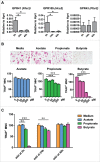Mechanisms of gut microbiota-mediated bone remodeling
- PMID: 28961041
- PMCID: PMC5914914
- DOI: 10.1080/19490976.2017.1371893
Mechanisms of gut microbiota-mediated bone remodeling
Abstract
The mechanisms underlying the systemic effects mediated by gut microbiota are under active investigation. In addition to local, direct effects of gut microbiota on the host, metabolic products from microbiota may act peripherally, reaching distal organs through the circulation. In our recent publication we demonstrated that gut microbiota influence bone remodeling distally, promoting both bone resorption and formation. We proposed that these effects are mediated, at least in part, by the induction of insulin like growth factor (IGF-1) by the microbiota metabolite short chain fatty acids (SCFA). Here we explore additional mechanisms by which microbial metabolites could directly or indirectly alter host bone remodeling. We discuss whether SCFA directly modulate bone resorption by their actions on osteoclasts, and test the possibility that serotonin is another gut microbiota derived long-distance mediator of effects on bone remodeling. A detailed understanding of the mechanisms of microbiota effect on bone remodeling could help establish potential therapeutic strategies to promote bone health.
Keywords: GPR109; SCFA; bone; gut microbiota; serotonin.
Figures



Erratum for
- Addendum to: Yan J, Herzog JW, Tsang K, Brennan CA, Bower MA, Garrett WS, Sartor BR, Aliprantis AO, Charles JF. Gut microbiota induce IGF-1 and promote bone formation and growth. Proc Natl Acad Sci USA. 2016 11 22; 113(47):E7554-E7563. Epub 2016 Nov 7.
Similar articles
-
Gut microbiota induce IGF-1 and promote bone formation and growth.Proc Natl Acad Sci U S A. 2016 Nov 22;113(47):E7554-E7563. doi: 10.1073/pnas.1607235113. Epub 2016 Nov 7. Proc Natl Acad Sci U S A. 2016. PMID: 27821775 Free PMC article.
-
Formation of short chain fatty acids by the gut microbiota and their impact on human metabolism.Gut Microbes. 2016 May 3;7(3):189-200. doi: 10.1080/19490976.2015.1134082. Epub 2016 Mar 10. Gut Microbes. 2016. PMID: 26963409 Free PMC article. Review.
-
Gut Microbiota and IGF-1.Calcif Tissue Int. 2018 Apr;102(4):406-414. doi: 10.1007/s00223-018-0395-3. Epub 2018 Jan 23. Calcif Tissue Int. 2018. PMID: 29362822 Free PMC article. Review.
-
Microbiota metabolite short chain fatty acids, GPCR, and inflammatory bowel diseases.J Gastroenterol. 2017 Jan;52(1):1-8. doi: 10.1007/s00535-016-1242-9. Epub 2016 Jul 23. J Gastroenterol. 2017. PMID: 27448578 Free PMC article. Review.
-
Short-chain fatty acids: microbial metabolites that alleviate stress-induced brain-gut axis alterations.J Physiol. 2018 Oct;596(20):4923-4944. doi: 10.1113/JP276431. Epub 2018 Aug 28. J Physiol. 2018. PMID: 30066368 Free PMC article.
Cited by
-
Biological Activities of Lactose-Based Prebiotics and Symbiosis with Probiotics on Controlling Osteoporosis, Blood-Lipid and Glucose Levels.Medicina (Kaunas). 2018 Dec 3;54(6):98. doi: 10.3390/medicina54060098. Medicina (Kaunas). 2018. PMID: 30513975 Free PMC article. Review.
-
Characteristics of intestinal microbiota in children with idiopathic short stature: a cross-sectional study.Eur J Pediatr. 2023 Oct;182(10):4537-4546. doi: 10.1007/s00431-023-05132-8. Epub 2023 Jul 31. Eur J Pediatr. 2023. PMID: 37522979
-
Obesity, but not high-fat diet, is associated with bone loss that is reversed via CD4+CD25+Foxp3+ Tregs-mediated gut microbiome of non-obese mice.NPJ Sci Food. 2023 Apr 13;7(1):14. doi: 10.1038/s41538-023-00190-6. NPJ Sci Food. 2023. PMID: 37055440 Free PMC article.
-
Review: Application of Protein-Based Raw Materials in Health Foods in China.Foods. 2024 Dec 25;14(1):20. doi: 10.3390/foods14010020. Foods. 2024. PMID: 39796310 Free PMC article. Review.
-
Melatonin alleviates titanium nanoparticles induced osteolysis via activation of butyrate/GPR109A signaling pathway.J Nanobiotechnology. 2021 Jun 6;19(1):170. doi: 10.1186/s12951-021-00915-3. J Nanobiotechnology. 2021. PMID: 34092246 Free PMC article.
References
Publication types
MeSH terms
Substances
Grants and funding
LinkOut - more resources
Full Text Sources
Other Literature Sources
Miscellaneous
